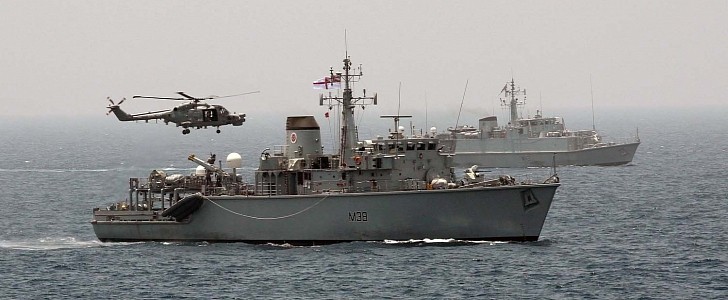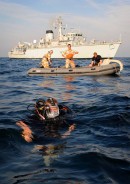Although not as imposing and powerful as aircraft carriers or frigates, minehunters are some of the most important assets in the British Royal Navy’s fleet. It’s been 15 years since these vessels and their crews have supported security for maritime transportation in the Gulf region, and thousands of sailors, from mine warfare experts to seamen and chefs, have celebrated this milestone.
The Gulf area is essential for international trade, and the huge shipping flow between the Indo-Pacific area and Europe needs to be protected from potential harm, including mine threats. The Royal Navy’s mission was initially called Operation Aintree and was kicked off with just two minehunters sent to Bahrain.
That mission would later be doubled in size, boasting a mothership, a dedicated command staff, and a permanent home (since 2018, the UK Naval Support Facility Bahrain).
Now known as Operation Kipion, the mission is carried out by minehunters on a regular rotation – each vessel completes a three-to-four-year deployment before handing things over to the next one. They constantly monitor a huge area of over 3,500 square miles (9,064 square kilometers) using highly-advanced sonar and sensors to detect and remove mines. This keeps essential shipping routes safe.
The Royal Navy’s Mine Counter Measure Vessels (MCMVs) are 60-meter-long (196.8 feet) and have a range of up to 1,500 nautical miles (1,726 miles/2,778 km). According to the Royal Navy, their cutting-edge sonars can detect and classify objects as small as a football at 1,000 meters (3,280 feet) away.
They’re designed to detect mines and lost explosives in the seabed, which are then destroyed either by the vessel’s clearance diving crew or through the SeaFox Mine Disposal system. This weapon system is also used to protect frigates from grenades, explosives, and short-range missiles.
Thousands of crew members celebrated 15 years of Operation Kipion in the Gulf area aboard the famous historic ship HMS Victory, which is also a museum. A new chapter in the mission’s history is about to start, with autonomous boats joining the traditional minehunters for the first time in history.
That mission would later be doubled in size, boasting a mothership, a dedicated command staff, and a permanent home (since 2018, the UK Naval Support Facility Bahrain).
Now known as Operation Kipion, the mission is carried out by minehunters on a regular rotation – each vessel completes a three-to-four-year deployment before handing things over to the next one. They constantly monitor a huge area of over 3,500 square miles (9,064 square kilometers) using highly-advanced sonar and sensors to detect and remove mines. This keeps essential shipping routes safe.
The Royal Navy’s Mine Counter Measure Vessels (MCMVs) are 60-meter-long (196.8 feet) and have a range of up to 1,500 nautical miles (1,726 miles/2,778 km). According to the Royal Navy, their cutting-edge sonars can detect and classify objects as small as a football at 1,000 meters (3,280 feet) away.
They’re designed to detect mines and lost explosives in the seabed, which are then destroyed either by the vessel’s clearance diving crew or through the SeaFox Mine Disposal system. This weapon system is also used to protect frigates from grenades, explosives, and short-range missiles.
Thousands of crew members celebrated 15 years of Operation Kipion in the Gulf area aboard the famous historic ship HMS Victory, which is also a museum. A new chapter in the mission’s history is about to start, with autonomous boats joining the traditional minehunters for the first time in history.






